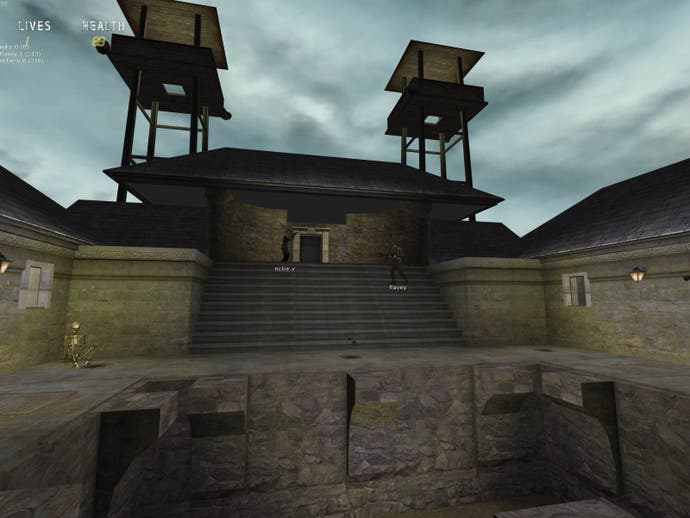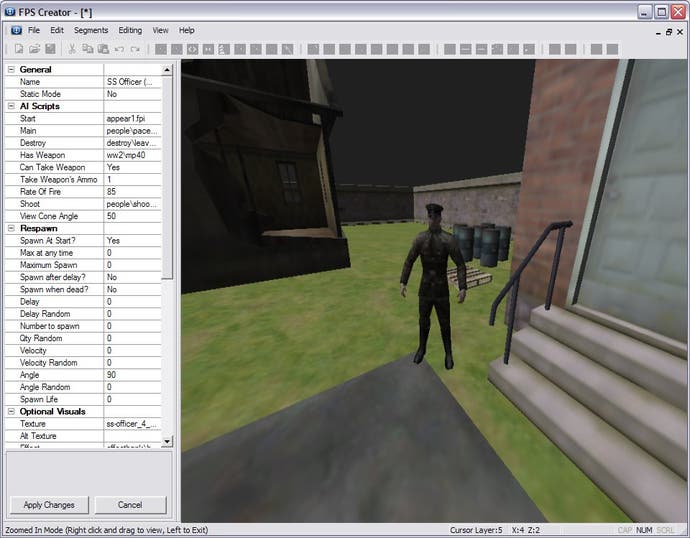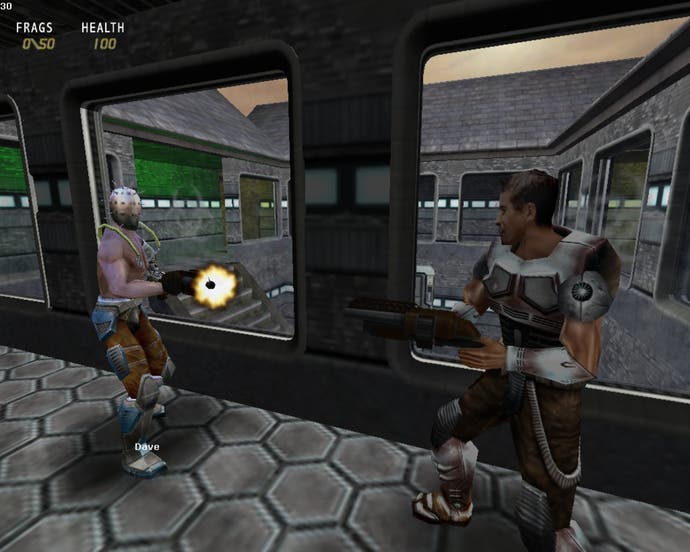First-Person Shooter Creator
Move over, Valve. Eurogamer, taking ovvvvahhh.
There's a moment in most serious gamers' lives. They find themselves looking at a game in disgust and thinking, "Christ - it can't be that hard". And then, later, they find themselves looking at an enormous manual of some kind and thinking, "Christ - does it have to be that hard?". And it's the evolutionary niche between those two urges that creation-systems like this one colonise.
FPS Creator belongs to the long history of user-friendly tools aimed primarily at the dabbler in the audience. That is, simplify it as much as possible, while still leaving enough room for player-expression. From Sensible's legendary 1988 Shoot-'em-up-Construction Kit onwards, we've seen game-makers emerge allowing the creation of games that are best described as having brought more pleasure to the creator than anyone who played them [What about text adventure creator The Quill? - Ed]. Which is only fair - they're the ones who paid for the box.
So: The First-Person Shooter Creator. It lets you create first-person shooters. Is it any good?
In the name of aiding the discussion, here's one we made earlier. It's 45 Mb, so go and read some news stories and come back later. When you play, understand it was compiled with the game's low texture set, only has minimal light mapping, and you'd be better off looking at the developer's community to see what FPS Creator can do at an optimum level rather than just a games-journo messing around level.
(All this assumes the technical magicians who serve the towering edifice that is Eurogamer manage to make it work. But I have faith. Do you have faith, comrades? Remember: Every time you don't have faith in a download, a fairy dies.)
User-friendly creator kits are always a balance between the simplicity they offer and the limitations they present you, with a surfeit in one area normally leading to a lack in the other. In this area, FPS Creator actually impresses, striking a happy medium. It works on a grid-based system, where you can quickly lob cubes to form a basic structure, adding individual walls and so on. Add enemies, and they automatically have workable AI. Pathfinding is simple to set up, if you wish. Its real-physics operate happily by themselves. There's even the option to create multiplayer levels. However, it also leaves itself open for increasing customisation - you can easily change AI scripts and details on all the characters or objects to change their function. More advanced users can actually have a crack at writing their own AI with its simple and pretty powerful script creation system. Anything you want to import, you can: models, textures, sounds...

If you've downloaded the example, have a play. Yes, it's phenomenally short, but bear in mind it's from someone who's just read the manual, performed some rudimentary experiments and followed the tutorial before deciding to see what they could stick together in just over two hours. You'd be lucky to have a box with a light in after two hours on modern UnrealEd.
(It's worth noting that these game creators are coming back into fashion. Back in Doom, there was no need for an FPS-creator. Doom's Ed was simple enough for anyone to lob together a decent level fairly easily. As we've moved on, the level editor complexity's increased to the point where that unless you're a serious careerist or insane hobbyist, you're going to end up with distinctly unimpressive work, and take years to do that. Not a problem here. The pleasure is the painting, and seeing the painting finished.)
That I've managed to lob together a playful mini-game for my own entertainment in two hours is a major testament to its flexibility. And there's the problem - that while it took me two hours to get it operating in a way which you can play, it took me another three or so to actually get it in a state which I could consider uploading.

It's unacceptably shaky for a casual user. One of its major attractions is that it's able to compile its own executable that can be freely distributed (or even charged for). This sequence particularly seems to be unreliable to the point of annoyance. Forget the few hangs I had - and there were a few - but the compiled game often differed from the levels as they were in the editor in unpredictable ways.
The biggest problem was that a series of crash bugs inserted themselves in the second level. I eventually solved the problem by simply removing all the game elements which caused them. Since these were the enormous full-black screens with enormous white text (like the one at the start) showing your character's increasingly psychotic mind-state about Nazis (and SKELETON NAZIS!), it's left the second level a tad bare and boring. Sorry. This was difficult to test because the game was fine in the editor, and in the full compiled game you have to run through the entire first level to see if the second level works - as one of the most noticeable missing features is a lack of a save game feature.
In other words, make a change, compile, go into the game to run to the error to see if it crashes, then repeat. Programmers in the house will be going "So what?" Yes, but it's your job. For me, it's bringing back terrible memories of the weeks I lost banging my head against DeusEx Ed when I was working on The Cassandra Project. That problems like this emerge when using the game at its very simplest level does not bode well for your sanity when making larger projects. The entire point of a streamlined creation tool like this is to cut away the worst hassles of "real" development at the expense of some power. This doesn't, so loses the majority of its appeal.

Another example of the odd twists in the compiling state: the game's opening. You start at the end of a long corridor, and you progress, each of the red lights click on in turn, guiding you down the corridor in my shoddy attempt at atmosphere. Well, they do if you actually play it from the editor. When you play in the compiled form, it only works with the first, with all the lights further down the corridor being on already. Why? I don't know, and there's no obvious way to find out except hours of slow fiddling.
While there may eventually be a worthwhile purchase here for anyone who'll like to spend a weekend making their own FPS rather than completing someone else's, at the moment it's in too rough a state to recommend in any way to any but the most determined. And the most determined... well; they'd probably be better off applying that determination to something without the training wheels.

